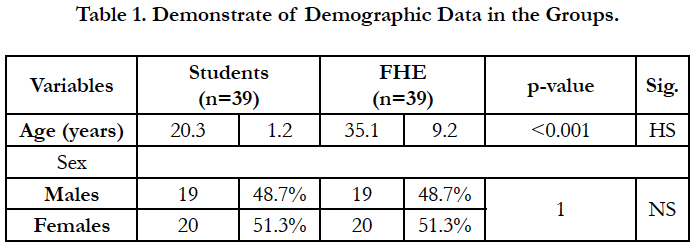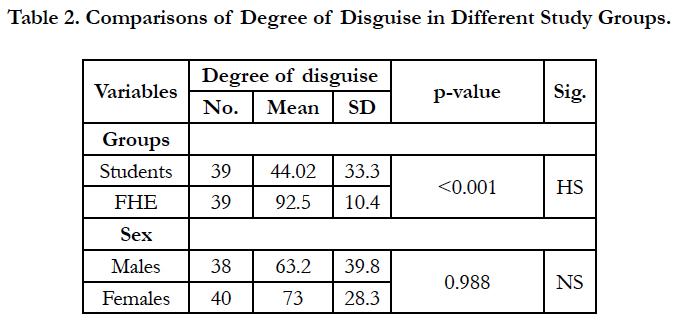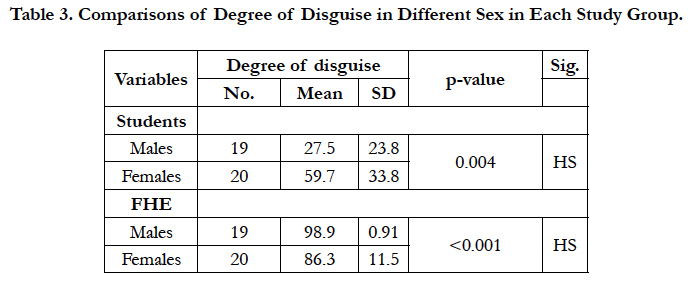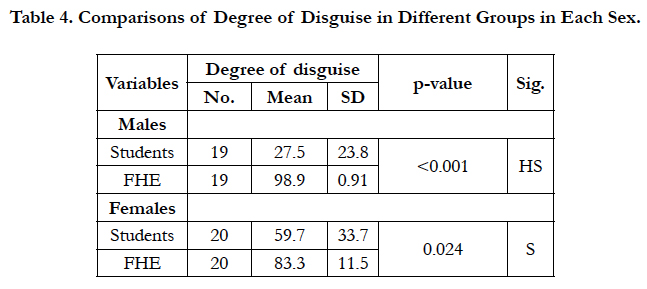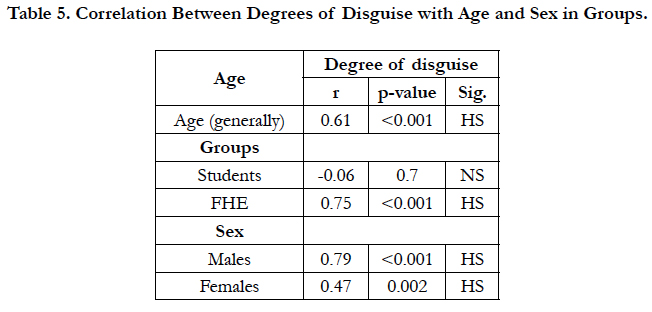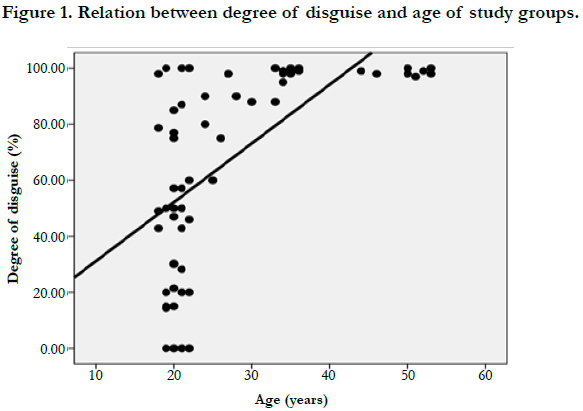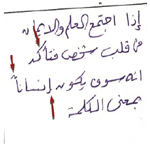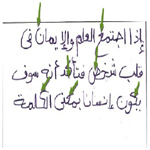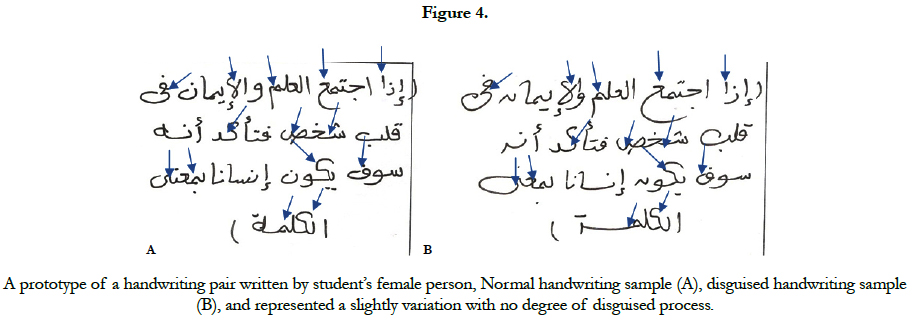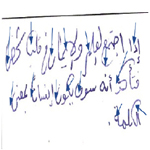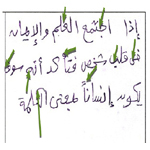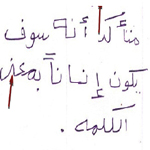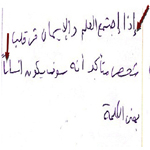The Probability to Prove the Distinguishing Handwriting Between Natural and Disguise of Egyptian Arab Writing
Mwaheb MA1*, Rashed KE2, Salim AS2
1 Faculty of Medicine, Department of Forensic Medicine and Clinical Toxicology, Fayoum University, Egypt.
2 Department of Counterfeiting and Forgery, Ministry of Justice, Egypt.
*Corresponding Author
Marwa A.Mwaheb
Department of Forensic Medicine and Clinical Toxicology,
Faculty of Medicine, Fayoum University, Egypt.
Email: marwa.mwaheb@yahoo.com
Received: July 01, 2017; Accepted: August 04, 2017; Published: August 07, 2017
Citation: Mwaheb MA, Rashed KE, Salim AS (2017) The Probability to Prove the Distinguishing Handwriting Between Natural and Disguise of Egyptian Arab Writing. Int J Forensic Sci Pathol. 5(5), 370-374. doi: dx.doi.org/10.19070/2332-287X-1700080
Copyright: Mwaheb MA© 2017. This is an open-access article distributed under the terms of the Creative Commons Attribution License, which permits unrestricted use, distribution and reproduction in any medium, provided the original author and source are credited.
Abstract
Background: In the forensic field examination, "a standard" is simply known item to which an unknown item can be compared. In the disguise Arab writing, we can attribute the disguised writing to its owner by looking to the dots, also by looking at the end of words and by looking at the end of sentences.
Method: The research design and methods of this study were approved by the Ministry of Justice and Fayoum University. Together handwritten samples for our study, 40 student volunteers, and 40 Forensic Handwriting expert’s volunteers.
Results: The current study showed a degree of disguise with high mean among (Forensic handwriting examination) FHE group. On the other hand showed moderate and low disguise among students group, which indicated increasing in age, will associate with increase ability and degree of disguise. Also, showed a degree of disguise with high mean among females in students group while with high mean among male in FHE group.
Conclusion: The solutions of disguised handwriting problems are often very difficult specific when there is a limited amount of writing such as a ratification on an investigation, or if only integrate standards are available.
2.Introduction
3.Methods
4.Materials
4.1 Ethics Approval
4.2 Statistical Analysis
5.Results
6.Discussion
7.Conclusion
8.References
Keywords
Disguised Writing; Forensic Science; Questioned Document Examination; Arab Writing.
Introduction
Handwriting identification proof has been assumptive in courts for over 100 years [1]. Disguised writings are being faced with quite repeatedly by the document examiner, especially in the case of obscure letters. In these cases, establishing the identity of the writer of disguised writings is a hard mission because of the contradiction in the writing [2, 8].
Disguised handwriting is the deliberate modulation of a person's natural writing for the aim of hide identity. As a subject it is growing in importance. Now people can be condemned of forgery on handwriting certificate alone, and these data encourage many criminals to disguise their handwriting in an attempt to evade justice. Most layman has the traditional impression that disguise means strange writing as establish in blackmail and hijack notes and in some unknown letters [3].
Disguised handwriting is the stubborn modification of a person’s natural Major laity has the traditional impression that disguises means dissonant writing as found in blackmail and abduct notes and in some obscure letters. Actually, dissonant disguise is the exception. Disguised writing is used more frequently for passing fanciful checks and writing comparison specimens. However, the most common and practicable disguise is one which endeavour not only to keep the writer anonymous but that also appears to be natural handwriting, thus urging no suspicion [4].
Methods
The research design and methods of the current study were acceptable by the Ministry of Justice and Fayoum University. To gather handwritten samples for our study, 40 student volunteers and 40 Forensic Handwriting experts (FHE) volunteers. Each volunteer was asked to copy 2 documents with different texts (text A and text B, shown in Figure 2 to Figure 8).
Materials
The trial consisted of 160 pairs of Arabic handwritten text, each pair written by one writer, with 80 writers in total. One of the specimens in the handwriting pairs was the writer’s normal handwriting, in either upper or lowercase print, and the other was a disguised handwriting sample in the same case. No directions were given to the handwriting providers as to how to disguise their handwriting. All writings were made using the same synthetic of ballpoint pen and the same synthetic of white paper.
Approval for this study was obtained from the Fayoum University Human Ethics Committee on the basis that the handwriting supplier and test participants gave full consent for samples of their handwriting, or research data provided by them respectively, to be included in released material.
• Data were collected and coded to facilitate data manipulation and double entered into Microsoft Access and data analysis was performed using SPSS software version 18 in windows 7.
• Simple descriptive analysis in the form of numbers and percentages for qualitative data, and arithmetic means as central tendency measurement, standard deviations as measure of dispersion for quantitative parametric data, and inferential statistic test:
- Mann-Whitney test in comparing two independent groups.
- Chi square test to compare two of more than two qualitative groups.
- Mc-Nemar test for paired dependant qualitative data.
- Bivariate Pearson correlation test to test association between variables.
• The p-value ≤ 0.05 was considered the cut-off value for significance.
Results
The present study on 40 student volunteers and 40 Forensic Handwriting experts (FHE) volunteers. Each volunteer was asked to copy 2 documents with different texts. Table (1) illustrates that there is statistically significant difference with p-value <0.05 between different study groups as regards age with high mean among FHE group. On the other hand there is no statistically significant difference with p-value >0.05 as regards sex distribution. Table (2) illustrates that there is statistically significant difference with p-value <0.05 between different study groups as regards degree of disguise with high mean among FHE group. On the other hand there is no statistically significant difference with p-value >0.05 in degree of disguise between different sex.
Table (3) showed that there is statistically significant difference with p-value <0.05 between different sex among students group as regards degree of disguise with high mean among females. Also there is statistically significant difference with p-value <0.05 between different sex among FHE group as regards degree of disguise with high mean among males. Table (4) showed that there is statistically significant difference with p-value <0.05 between different FHE groups among males, and among females as regards degree of disguise with high mean among FHE group. Table (5) illustrates that there is statistically significant positive correlation with p-value <0.05 between degree of disguise and age, which indicated increasing in age, will associate with increase ability and degree of disguise.
Also there is statistically significant positive correlation with pvalue <0.05 between degree of disguise and age, among FHE group and among each sex which indicated increasing in age, will associate with increase ability and degree of disguise in each group. On the other hand there is no statically significant correlation with p-value <0.05 between degree of disguise and age in students group. The figure (1) demonstrates relation between degree of disguise and age of study groups. A prototype of a handwriting pair written by FHE and students groups, Normal handwriting sample (A), disguised handwriting sample (B), and represented a very variation with degrees of disguised process in figures from (2-8).
Discussion
Questioned documents have always been a defy in forensic investigations. The disguising of handwriting is the most common practice in white collar crime. In case of disguise, people deliberately change their usual pattern of writing with the intent to disavow of the originality same in future for some clear benefits. There may be abundant methods to disguise the original handwriting and disguise handwriting depending upon the ability of the writer and the goal behind disguising [1, 9].
The present study on 40 student volunteers and 40 Forensic Handwriting experts (FHE) volunteers illustrates that there is statistically significant difference with p-value <0.05 between different study groups as regards degree of disguise with high mean among FHE group. On the other hand there is no statistically significant difference with p-value >0.05 in degree of disguise between different sex. These results agree with another research showed that for the FDEs (Forensic Document Experts) and laypeople are compared, it is clear that there is a difference in the response profiles between the two groups. provides a summary ofthe correct, misleading, and inconclusive responses for the group of FDEs and laypeople tested [5]. The results reported that aligned with the trend evident in these previous findings where FDEs exhibit a greater skill in determining which of a pair of handwriting samples was disguised.
Moreover, as in the research documented by Sita, et al., [6], FDEs were found to be more conservative than their untrained although the raw scores indicate that laypeople have a higher correct rate than FDEs, this difference is not significant (t = 1.81, df = 19, p = 0.086); however, the error rate of FDEs is less than a third of the error rate of laypeople (3.38% compared with 11.43%, t = 4.08, df = 19, p < 0.001). This means that when participants were willing to give an opinion on which of a pair of handwriting samples was disguised, the FDEs have a significantly higher correct rate than laypeople (95.66% correct called compared to 87.84%, t = 3.86, df = 19, p = 0.001) [7].
This is the first analysis of the Egypt handwriting identification disposal by experts with precious research on the effect that exchange of vision among handwriting identification experts has on the ratio of degree of disguise in different groups present in this study.
Conclusion
In an endeavour to disguise writing, a writer may change normal handwriting with the idea that significant changes in the appearance of the writing will help to conceal their composition successfully. But such a writer is insensible that in doing so they have introduced one character in their writing which is very specific, mention that the hand for writing has been changed to perform the disguise.
References
- Misra VC, Agrawal N, Shukla SK (2016) A study on the rarest case of Disguised Signatures in the form of Lateral expansion, Res J Recent Sci. 5(2): 51-55.
- Huber RA, Headrick AM (1999) Handwriting identification: facts and fundamentals. Boca Raton, FL: CRC Press.
- Risinger DM, Denbeaux MP and Saks MJ (1989) Exorcism of ignorance as aproxy for rational knowledge: The lessons of handwriting identification‘‘expertise’’. U Pa L Rev. 137(3): 731–92.
- Risinger DM, Saks MJ (1996) Science and nonscience in the courts: Daubertmeets handwriting identification expertise. Iowa Law Rev J. 82: 21–74.
- Carolyne B, Bryan F, Doug R (2010) Forensic Document Examiners’ Skill in Distinguishing Between Natural and Disguised Handwriting Behaviors. 55(5): 1291-1295.
- Sita J, Found B, Rogers D (2002) Forensic handwriting examiners’ expertise for signature comparison. J Forensic Sci. 47(5): 1117–24.
- Kam M, Gummadidala K, Fielding G, Conn R (2001) Signature authentification by forensic document examiners. J Forensic Sci. 46(4): 884–8.
- Anitha, OP Jasuja (2016) Mirror writing: A Trait of writing with an unaccustomed hand. Prob Foren Scie. 106: 444-455.
- Dziedzic T (2013) Right hand writing vs. left hand writing of one person. A comparative study. Prob Foren Sci. 94: 564–577.

